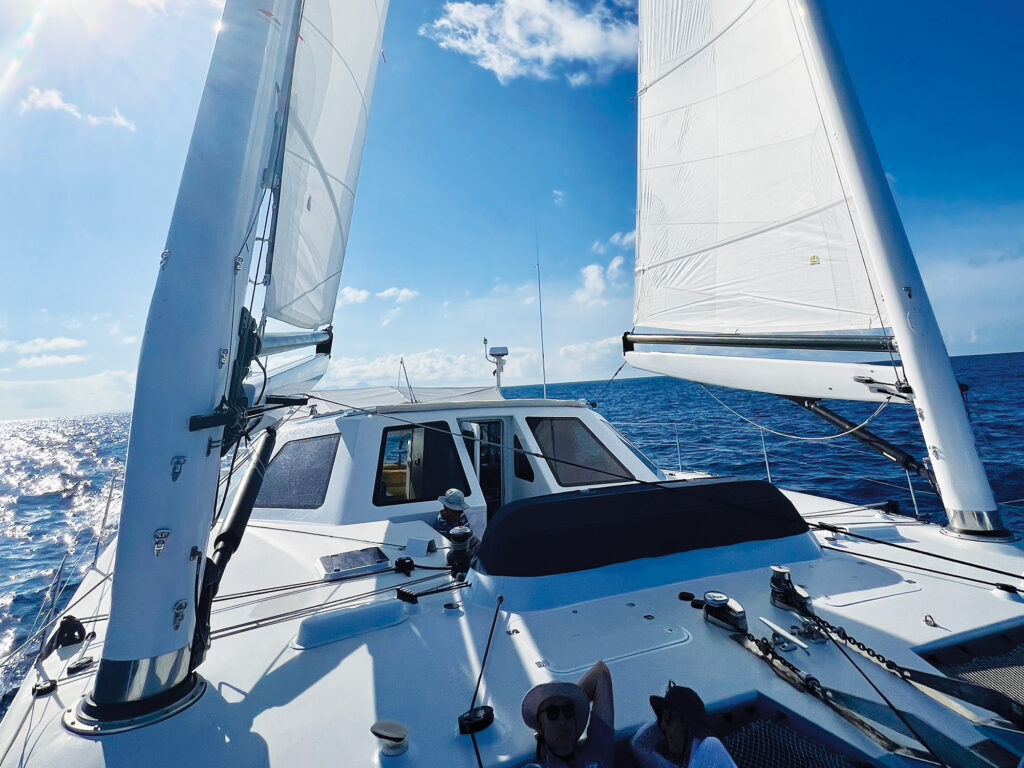
At the dawn of Chinese New Year in February, Jennifer and Peter Francis were hiding out in the Marquesas aboard Saphira, their 70-foot catamaran named for the strong, loyal blue dragon in the book Eragon. Saphira is their second cat designed by Chris White, but it’s a whole different species adapted for their current phase of life. On the first morning in this Year of the Dragon, Jennifer says, “It should be a good year for Saphira.”
The Marquesas wasn’t in their plan for this cruising season, until El Niño generated rougher weather than usual in French Polynesia. “We decided to leave Tahiti and sail 750 miles northeast to the Marquesas to avoid a busy year for tropical storms,” Jennifer says, adding that they made landfall at the island of Fatu-Hiva. They had just set Saphira’s anchor when a dinghy came by—a Vancouver couple they’d met in Mexico’s Sea of Cortez, cruising on another catamaran from the same designer.
White is known for his Atlantic series of cats, and for innovations such as the MastFoil rig and forward-positioned cockpit. The Francises’ previous cat was an Atlantic 55 (their first Saphira). Their 70-footer came to life starting in 2010, the year that White says Peter told him: “When our kids head off to college, Jen and I are going back to the cruising life. We’ll be in touch later.” The next summer, Peter visited White’s shop in Dartmouth, Massachusetts, with broad ideas for a cat that could do it all. “Their concept was a boat with the space of a 40-footer built for two people to sail easily by themselves, but with hulls of about 60 to 70 feet to safely make 300 miles in a day,” White says. “Anything less than 250 would be a failure. And they were interested in a free-standing rig. More than most clients, they had deep experience and knew what they wanted.”
Combined, Peter and Jennifer have logged around 100,000 miles on the oceans. Peter started sailing as a kid, when his family had a Cape Cod 30. At age 12, he’d cruise to Cuttyhunk, Massachusetts, and the nearby islands with friends. At 16, he raced trans-Atlantic and was on the US Admiral’s Cup team. He completed three trans-Atlantic crossings by 20. In 1974, he met Jennifer, a local gal and fellow sailor. That same year, Peter and his friends sailed his first boat, the 50-foot Aage Nielsen sloop Nunaga, through the Panama Canal and beyond to the Galapagos, French Polynesia, Hawaii, Alaska and Seattle. Jennifer joined them in Alaska.
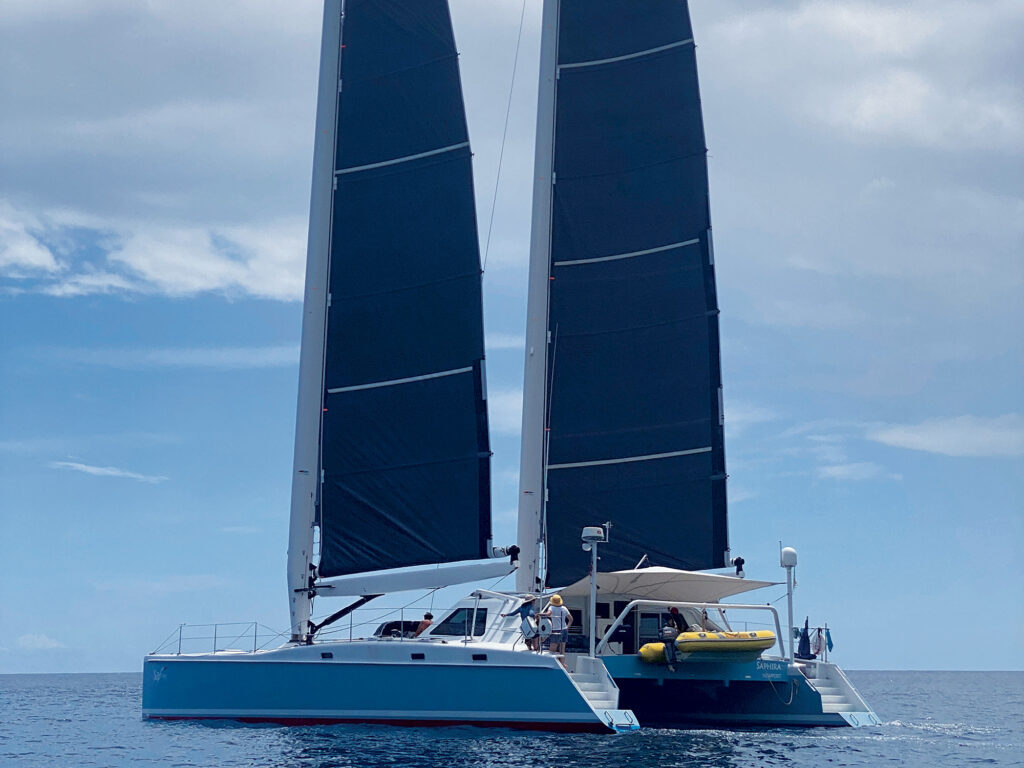
At various times since then, the couple has spent years together—alone and with their children—living aboard boats. In 2009, Peter retired from his position as a corporate CEO, and Jennifer took a sabbatical from her job as a professor of atmospheric sciences at Rutgers University. They pulled their children out of seventh- and ninth-grade classes, and sailed their first Saphira for 14 months from Massachusetts up to Nova Scotia, then south to Colombia, and finally back home. Ever since, they’ve lived in Massachusetts—or wherever they’ve pointed the new Saphira’s bows.
Conceptual work for the 70-footer began in earnest in 2011. First, they bought two 23-foot Stiletto catamarans and modified one to take various rigs. For three summers, they hired a friend who was a good sailor to evaluate each rig. They also invited sailor friends to match race—singlehanded, to emphasize ease of handling. White also tested his MastFoil rig on the Stilettos.
“First they tried two masts positioned fore and aft, then with them side by side,” White says. “They experimented with normal booms as well as wishbones.”
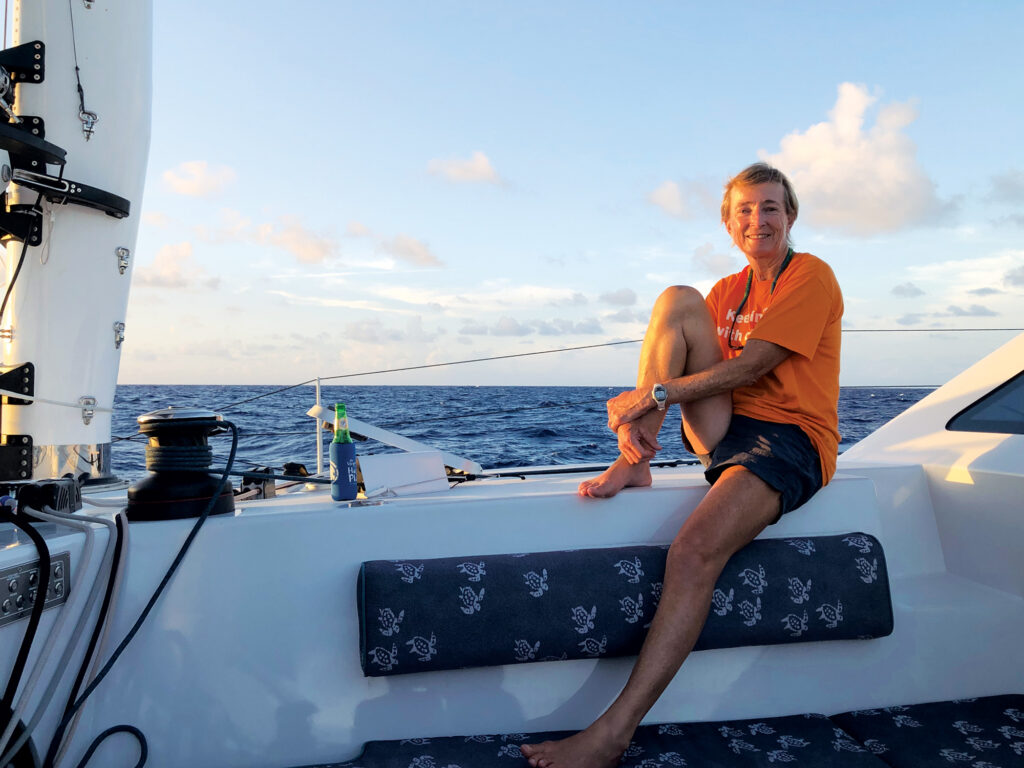
Peter says that 14 sailors tested all the rig configurations. Each day, after collecting performance data, the couple asked those sailors to rank the setup on a scale of 1 to 10, for how likely they would be to recommend the rig to an older couple going offshore cruising.
Then they plotted the results. On ease of handling, the biplane prevailed. They also found some unexpected sailing characteristics.
“Catamarans don’t tack particularly well, especially not light ones,” Peter says. “When sailing the biplane, we trim the leeward sail more than the windward one because the breeze ‘bends’ around the windward rig and presents a narrower apparent-wind angle to the leeward sail. When they tacked, the prior leeward sail became the windward sail and started earlier to ‘sail’ the windward hull around.”
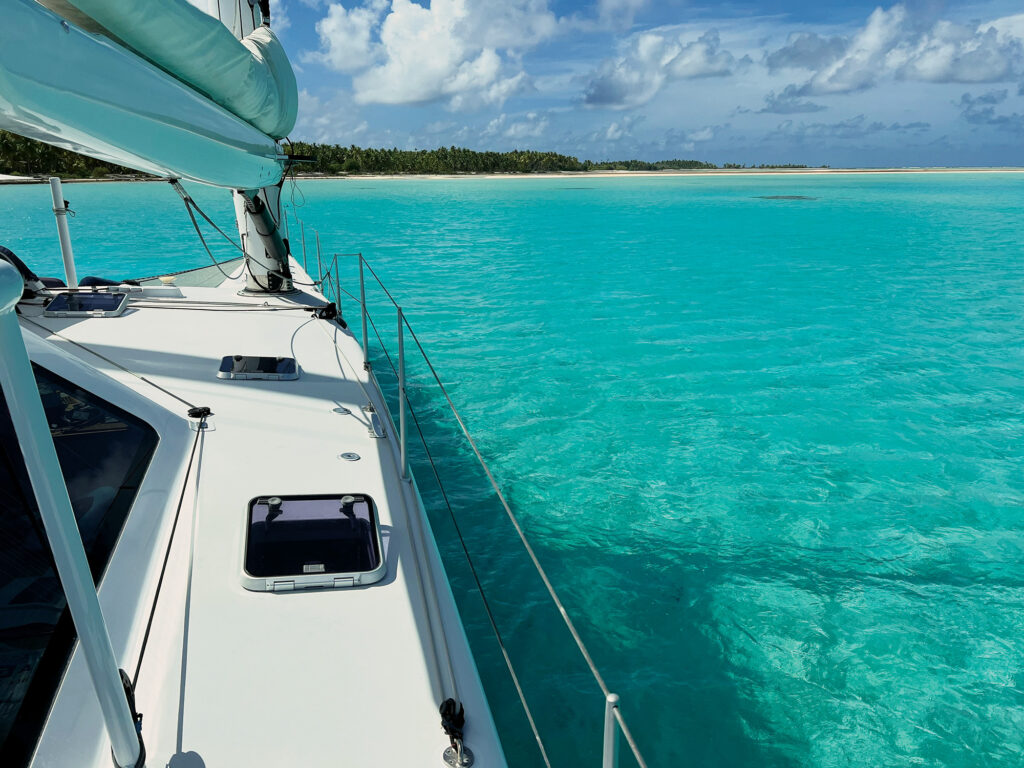
Another advantage appeared when sailing dead downwind, Peter adds. “You can wing-on-wing with both sails out at 90 degrees because of the full mast rotation, making for a very stable rig and also allowing you to steer up to 80 degrees on either side of the course without jibing.”
Nevertheless, the initial biplane Stiletto lost in the first trials. It didn’t match the standard rig’s performance. The team realized, however, that the biplane could handle longer booms than the sketch, and thus larger sails on same-height masts.
At first, this switch didn’t help performance, but once they made larger daggerboards to counteract the leeway from the increased sail area, the performance significantly bested all other rig configurations.
The couple preferred this setup too, especially for safety in the event of squalls.
The masts rotate 180 degrees each way but can rotate up to 270 degrees, so if you do need to release them to 180, nothing can break.
“With no standing rigging, you can depower on any point of sail by quickly easing,” White says.
The masts will rotate into the wind—what sailing instructors call safety position. When the couple tested the biplane again with larger sails, it blew away its competition.
“The final version on Saphira is a biplane with two big mainsails,” Peter says. “The masts rotate 180 degrees each way in normal operations but can rotate up to 270 degrees, so if you do need to release them to 180, nothing can break.”
Jennifer adds: “We have unreal visibility from the cockpit. There’s nothing to obstruct the field of view.”
Having settled on the rig, they focused the design process on three concepts: the biplane rig with fully rotating masts for safety and maneuvering; 70-foot-long narrow hulls with a beam, weight, and righting moment about the same as an Atlantic 55; and only two staterooms, to free space for comfort and ease of maintenance.
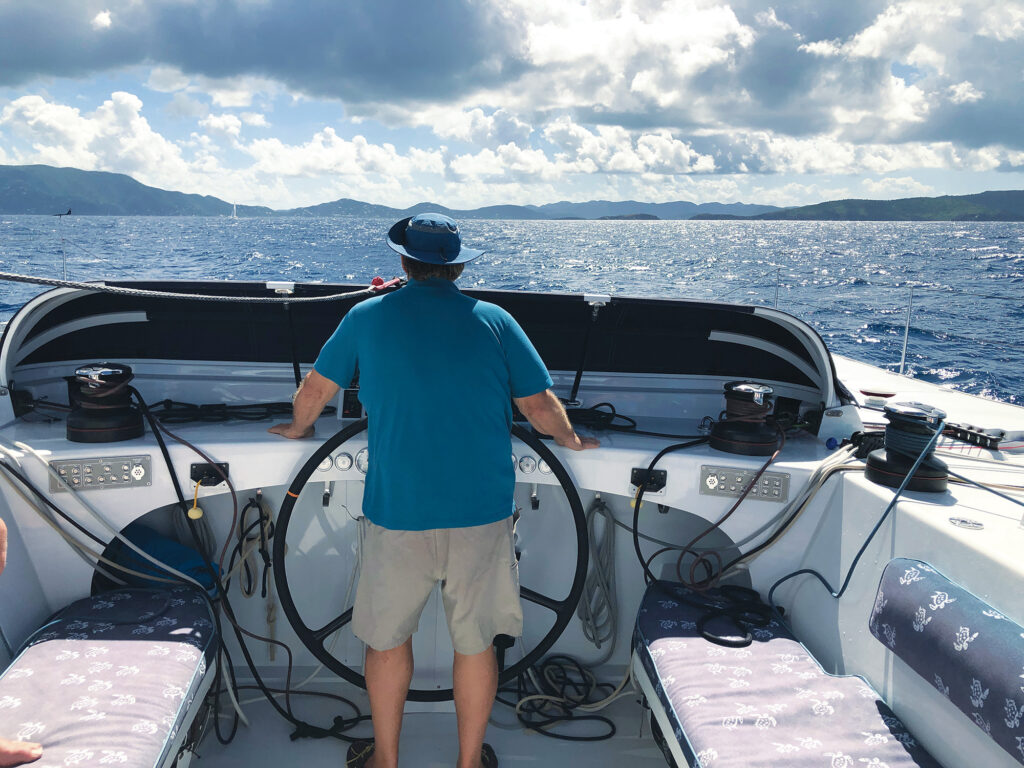
Saphira’s wing-shaped masts make up 7 percent of her sail area. At the first reef, the mainsails are normal in size, but when fully raised, they have the total area of an Atlantic 55 with its main and largest spinnaker flying. “Hull length leads to higher hull speeds and also seakindliness,” Peter says.
Combined with the narrow 28½-foot beam, this design also allows access to slips and Travelifts that often max out at 30 feet. And the extra length allowed White to design the hulls’ interiors
similarly to the Atlantic 55’s but with more space. For example, Saphira’s engine rooms occupy areas where aft staterooms would normally be, and four adults can stand with full headroom around the engines.
To balance speed and comfort, the couple assembled a team from the racing and cruising worlds, including experts from Doyle Sails, Southern Spars and SDK Structures.
“We’d sit at their dining table for hours, the room full of experts who have worked on America’s Cup boats for decades,” White says. “I was the mom-and-pop cruising boat designer guy.”
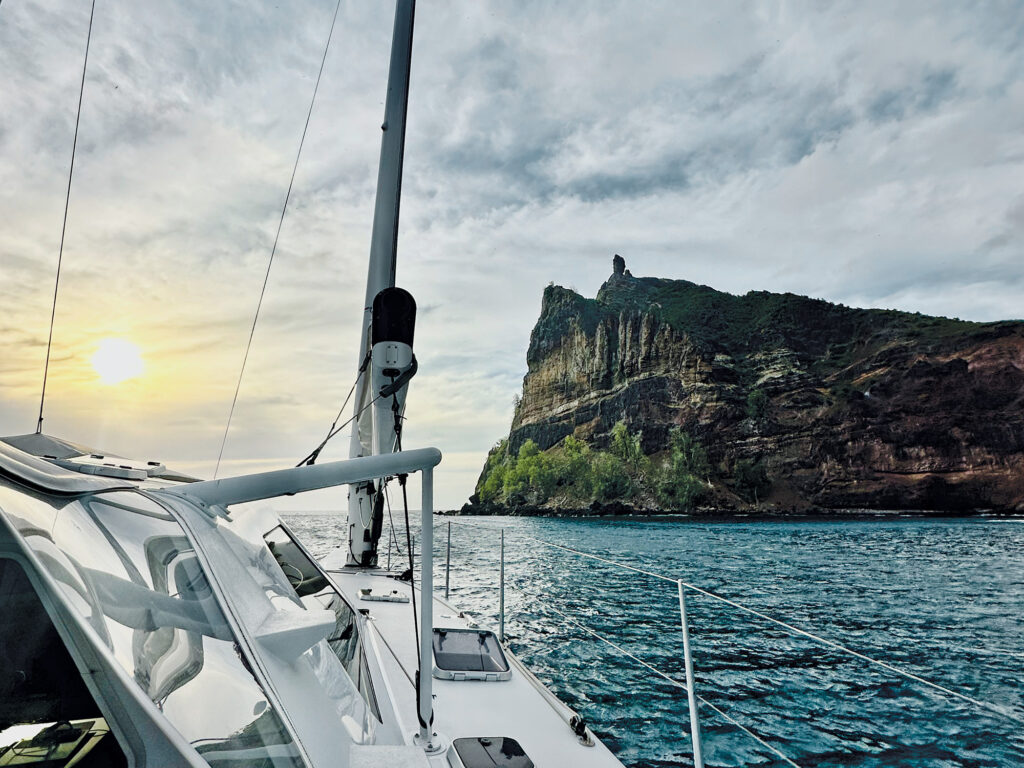
Peter says that the couple wanted White’s deep experience from decades of designing and building multihulls.
“We valued this for many reasons,” Peter says. “One additional design criterion was to make the living space practical and focus on ease of maintenance, given that Jen and I would be sailing on our own or with friends.”
The couple’s 750-mile passage to the Marquesas is the longest they’ve completed alone aboard Saphira, and it reconfirmed some goals that went into the design. With the cat’s stability at speed and shallow draft, it can go most anywhere. If one of French Polynesia’s tropical cyclones had whipped up, the couple would have been able to sail quickly to safer waters. As Peter says, “With our 11-knot average speed, we could escape the cone of probability in just two days.”
Recently, amid the craggy Marquesan coves and bays, they were treated to a shark feeding frenzy about 20 yards from their stern. They’re not entirely sure what’s next, but they love knowing that they can spread Saphira’s wings and take flight to wherever the weather looks fine and their whimsy desires.








